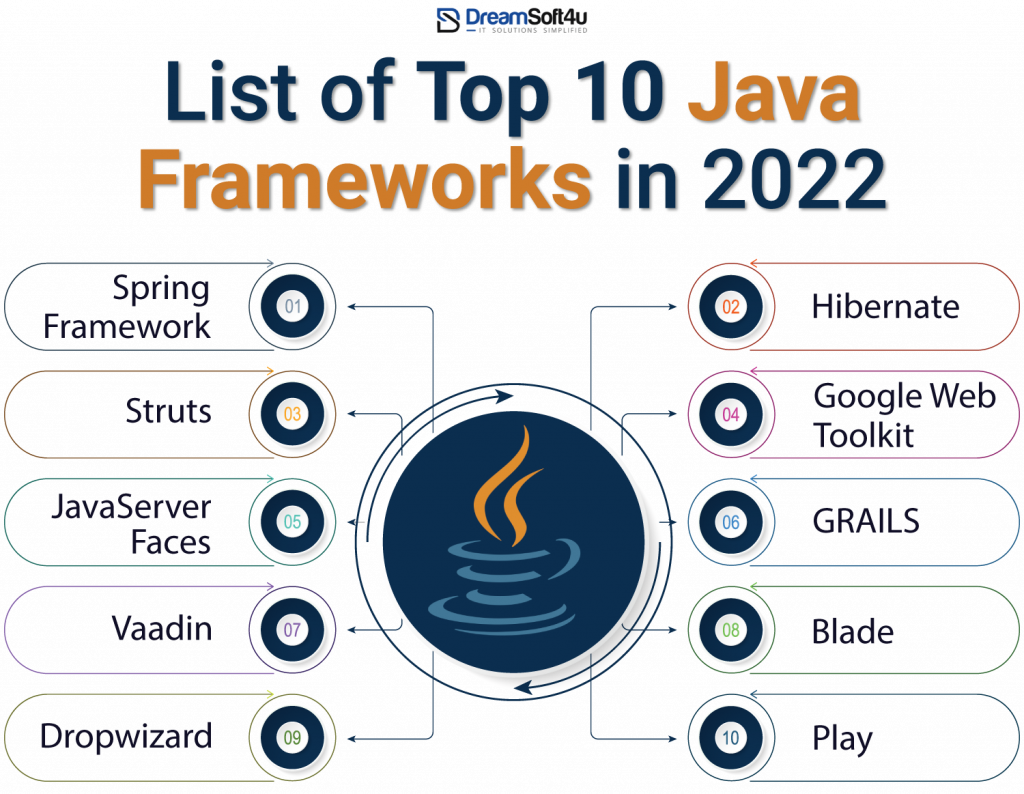Are you looking for the best Java frameworks? Do you want to enquire about the Java frameworks? Here, we have shared comprehensive information related to this popular technology.
In the article, we have come up with the best 10 Java frameworks you should know. But, what are Java frameworks? Let’s discuss it first.
Table of Contents
ToggleWhat is Java Frameworks?
Frameworks are large bodies of pre-written code that Java developers can use and reuse to develop an application by adding their code. A developer can’t create the application entirely from scratch. The developer needs a foundation to develop the application. Frameworks provide that foundation where a developer can develop their application.
A framework is related to a specific programming language, and these languages are performed in different tasks to create an application. Many programming languages are linked with Frameworks. Java Frameworks are one of them.
A Java framework is a platform that uses Java as its programming language to develop Java programs and software applications. It consists of functions and predefined classes to interact with system software, manage hardware services, and process input. It is also helpful when it comes to machine learning.
Let’s see some Java frameworks!
List of Top 10 Java Frameworks
So many Java frameworks in the market that are commonly used in different tasks- network applications, web applications, ORM, testing, logging, etc. Every framework has its features and benefits. It is difficult to tell which is better than whom, but they are a good choice for developers in different scenarios. Let’s discuss these Java frameworks as these are also being in use by the Java web application development company.

1. Spring Framework
Spring framework is a powerful and popular open-source Java development framework that offers a platform to develop Java applications. This framework is the most popular Java Enterprise Edition (Java EE). It helps developers create high-performing applications using POJOs ( Plain old Java objects).
Spring framework’s core feature is that it can be used in creating any Java application. There are some technologies- Aspect-oriented programming (AOP), Dependency injection (DI), and Plain old Java projects (POJOs) used in the framework that are offered by the Spring framework to simplify the complex Java application development process. The spring framework is still lightweight with all these technologies. Let’s see the use of the Spring framework in Java development services:
Uses of Spring Framework:
The followings are the uses of Spring Framework-
- To develop any Java application.
- It is used to develop web applications.
- It is used in the Java enterprise edition.
Benefits of Spring Framework:
The followings are the benefits of Spring Framework-
- A developer can develop enterprise applications that use plain old Java objects (POJOs). As a result, the developer doesn’t require an enterprise container.
- It provides the flexibility of using any between Java-based annotations and XML configuration to develop enterprise applications.
- There is no need for a web server or application server where the Spring framework is present.
- Technologies like ORM frameworks, Java EE, JDK timers, etc. Use by Spring framework. So, developers can develop the application without learning these techniques.
- It provides easy testability with the help of spring dependency injection.
- It delivers well-designed frameworks.
Many companies use the Spring framework to develop applications like eBay, Netflix, Amazon, Yatra, etc.
2. Hibernate
Hibernate is an open-source object-relational mapping tool utilized by many web development companies. It is not a Full-Stack framework. For data persistence, it implements Java Persistence API (JPA). It is responsible for improving communication between relational database management systems (RDMS) and the Java programming language.
Uses of Hibernate:
The followings are the uses of Hibernate-
- To solve the object-level relationship.
- Make better communication between Java programming languages and RDBMS.
- The database is independent using Hibernate Query language ( HQL).
- Supported Database in Hibernate.
The followings are the database supported by Hibernate in Java–
- Front base
- MYSQL
- DB2/NT
- Informix Dynamic Server
- HSQL Database Engine
- Sybase SQL Server
- Microsoft SQL Server Database
- PostgreSQL
Benefits of Hibernate:
The followings are the benefits of Hibernate-
- Hibernate is efficient and accessible because it is open-source and lightweight.
- It supports cache memory that increases performance.
- It offers you to work with different databases, which means data independence.
- It saves from manually creating tables by auto DDL operations.
- By using XML files, it maps the Java classes database without writing any code.
- By using simple APIs, You can store and retrieve data directly from the database.
- It provides simple querying of data.
- There is no need for an application server to operate.
- With innovative fetching strategies, you can minimize database access.
Major companies use Hibernate to develop applications like Oracle, IBM, Accenture, DELL, etc.
3. Struts
Struts is an open-source, full-featured Java web application framework. This is also used for developing web applications. Apache Software Foundation (ASF) maintains Struts. It is responsible for creating an easy-to-maintain Java application. It follows the Model-view-controller model.
It comes in two versions- Struts 1 and Struts 2. Most companies prefer Struts 2 because it is an advanced version of Struts 1.
Struts 2 is the combination of Struts1 and the webwork framework OpenSymphony.
Uses of Struts:
The followings are the uses of Struts-
- It is used to develop MVC-based web applications.
- It creates flexible applications that can be modified and extended easily without changes in actual business.
- It is automatically added to the XML configuration file whenever a new Java class is created.
- It provides security and integrity in web applications’ fast and efficient development.
Benefits of Struts:
The followings are the benefits of Struts-
- It makes web development easy.
- It is an open-source framework. So, it is available free in the market. Anyone can use it without spending any money.
- XML configuration is added to the file whenever new classes are created.
- It makes the manageability of the application easier by reducing the development time.
- It has an extension for testing purposes, the Junit plugin.
- It is flexible and easy to use, and maintenance is required.
Some major companies use this framework to develop applications like Infosys, Accenture, NextGen Technologies, etc.
4. Google Web Toolkit (GWT)
Google Web Toolkit (GWT) is a framework created by Google. It is a free and open-source framework that helps write Java-based client-side code. Most of the products of Google are created with the help of GWT, such as Google Wallet, AdSense, and Blogger. You don’t have to be an expert in writing complex browser-based applications like JavaScript optimization or responsive design. Let’s see some uses of GWT as the frontend framework for web development.
Uses of Google Web Toolkit (GWT):
The followings are the uses of GWT-
- It converts Java code into JavaScript code.
- You can write highly well-functioned web applications in less time.
- It helps in creating complex JavaScript-based web applications.
Benefits of Google Web Toolkit (GWT):
The followings are the benefits of GWT-
- It is a free and open-source framework.
- It offers easy integration with Maven and JUnit.
- You can develop awe-inspiring web applications.
- You can translate Java code into JavaScript code.
- You can create and optimize complex applications.
- You don’t have to be an expert in technologies like JavaScript, XMLHttpRequest, and browser quirks to create high-performance web applications.
5. JavaServer Faces (JSF)
JavaServer Faces is used for building user interfaces for Java-based web applications and was developed by Oracle. It is a component-based MVC framework. Let’s see some use of JavaServer Faces.
Uses of JavaServer Faces:
The followings are the uses of JavaServer Faces-
- The developers use it to create native applications.
- Build dynamic, data-driven web apps.
- Create rich enterprise portals with ease.
- Modernize legacy web applications seamlessly.
Benefits of JavaServer Faces:
The followings are the benefits of JavaServer Faces-
- It provides reusable user interface components.
- It allows easy transfer between User interface components.
- It provides rich libraries and excellent tools.
6. GRAILS
GRAILS is a Full-Stack framework and ideal for beginners to begin their programming career. It is written in Groovy JVM programming language. It is based on the MVC design pattern.
It is similar to Java. If you know Java, then it is easy to learn Groovy. It works with Java technologies like Hibernate, Sitemesh, Spring, EE container, and Quartz. Let’s see the uses of GRAILS.
Uses of GRAILS:
The followings are the uses of GRAILS-
- It is used for Agile web applications.
- It helps the developers to concentrate on actual application requirements.
Benefits of GRAILS:
The followings are the benefits of GRAILS-
- It is easy to learn GRAILS if you know Java.
- It provides flexible profiles.
- It is easy to read.
- It is very developer-friendly.
Major companies use this framework, such as Biting Bit, Secret Escapes, TransferWise, SiteMinder, Linkedin, Green Code, etc.
7. Vaadin
Vaadin is an open-source platform that uses to develop Java-based web applications. It focuses on UX accessibility. The programming language of Vaadin is Java. It supports both server-side and client-side development. It automates all the communication between the server and the browser.
Uses of Vaadin:
The followings are the uses of Vaadin-
- Quickly build enterprise-grade web apps.
- Ideal for data-driven projects.
- Simplify UI development with robust components.
Benefits of Vaadin:
The followings are the benefits of Vaadin-
- It offers multiple options such as layouts, many components, and different listeners.
- It is easy to learn and easily integrates with other frameworks.
- It helps in data binding.
- It supports a built-in spring.
- It supports JVM languages.
8. Blade
The blade is a high-performance MVC Java framework. It is based on Java 8. Its design is inspired by many frameworks like Python, Flask, Martini, and Node’s Express. It makes web API cleaner and synchronizes data with the website. It is used to create a small MVC application. Let’s see the benefits of Blade.
Use of Blade:
The followings are the uses of Blade-
- Light template engine.
- Best for small or specific functions.
- Streamline routing in your Java applications.
Benefits of Blade:
The followings are the benefits of Blade-
- It supports web jar resources, and
- Plug-in extension.
- It supports a Rest style routing interface.
- Its design is simple and easy to understand.
9. Dropwizard
Dropwizard is a lightweight framework that helps in developing web applications faster. It is suitable for creating Java microservices. It brings many libraries into one framework to create a lightweight and lean application. Let’s see some benefits of this framework.
Uses of Dropwizard:
The followings are the uses of Dropwizard-
- Build fast micro-services.
- Known for simplicity.
- Efficiently handle configuration tasks.
Benefits of Dropwizard:
The followings are the benefits of Dropwizard-
- It creates high-performance RESTful web services.
- It supports many libraries, whether they are open-source or independent libraries.
- It helps in increasing productivity.
10. Play
Play is an open-source MVC pattern web application framework. It is a unique and conventional type of framework. It doesn’t depend on the standards of Java EE. Due to similarities with ASP.NET, Ruby on Rails, and Django, it constantly compares with them. Let’s see some benefits of Play.
Uses of Play:
The followings are the uses of Play-
- Full-stack web app framework.
- Faster development with hot code reloading and built-in tools.
- Facilitates asynchronous and reactive programming.
Benefits of Play:
The followings are the benefits of Play-
- It supports non-blocking I/O.
- It offers asynchronous processing.
- It has many features like error messages in the browser, hit code reloading, convention over configuration, etc.
Get A Best Java Framework
Click here to get the best java framework for web development.
Conclusion
In the article, we have discussed the best 10 Java frameworks. Some of them are Full-Stack frameworks or web development. We also mentioned what the framework and Java framework are. We discussed each Java framework, its uses, and its benefits. We hope that the article will be helpful for you.
FAQs
Q1. What Java development services do you offer?
Our Java services include web & mobile application development, industry-specific software solutions, and more. We also offer Java app maintenance and support services.
Q2. How experienced is your Java development team?
The average experience of our JAVA team is 10+ years, collectively completing 50+ successful projects.
Q3. What project size can you manage with ease?
We have the technology stack and experience to handle projects of all sizes. We have delivered over 100 Java-based projects, from small to big.
Q4. What industries do you serve with your Java development services?
We offer our services to finance, healthcare, e-commerce, and more. Our solutions are customizable and scalable as per need.
Q5. What is the typical timeline for Java development projects?
For small to medium projects, expect delivery within 4-8 weeks. Larger enterprise-level solutions may take 12-16 weeks, ensuring a thorough and quality outcome.
Q6. How can I get started with your Java development services?
Simply fill out our contact form or email us. We’ll discuss your Java app development needs and provide a tailored solution.











